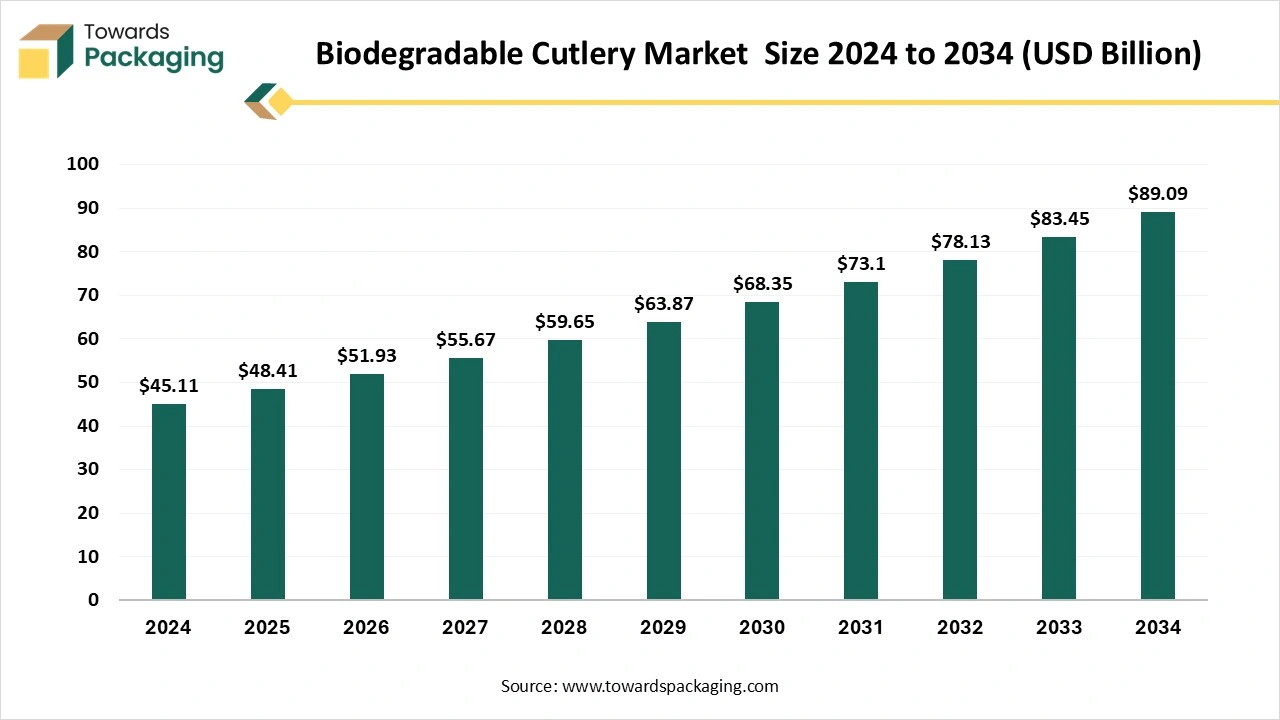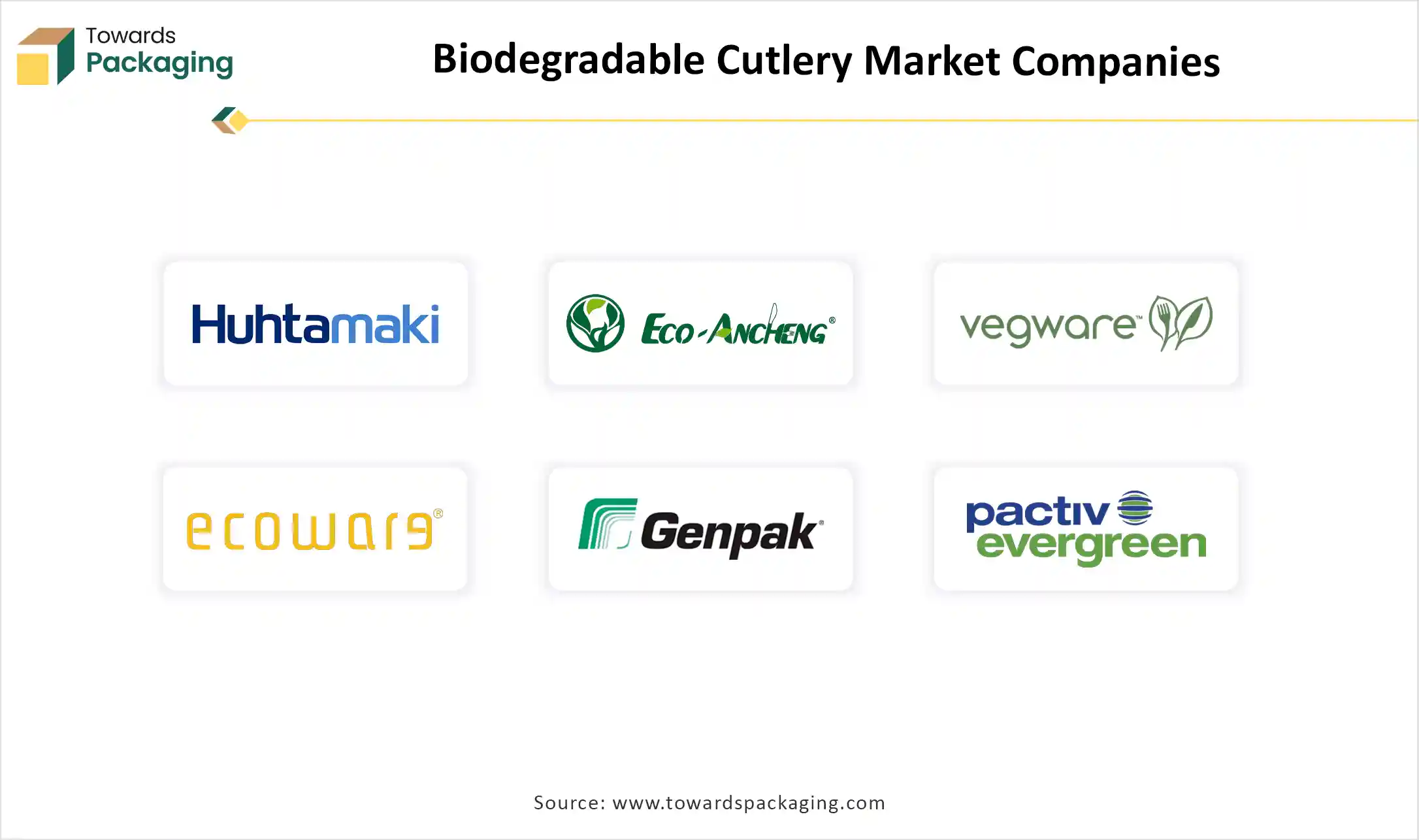December 2025
The biodegradable cutlery mar ket is expanding strongly, reaching USD 48.41 billion in 2025 and projected to grow to USD 89.09 billion by 2034 at a 7.3 percent CAGR, driven by regulations on single-use plastics and rising adoption of eco-friendly materials. The market covers raw materials such as wood, husk, paper, and plant-based plastics, with wood leading in 2024 and paper expected to grow fastest. Regionally, Europe dominated the market, while Asia Pacific will record the highest CAGR, supported by government bans and urban consumption. North America, Latin America, and the Middle East & Africa are also adopting biodegradable alternatives in food service and retail.
The competitive landscape includes global companies such as Huhtamaki, Eco-Ancheng, Vegware, Ecoware, Genpak, Pactiv, Biotrem, Eco-Products, and others. The report covers value chain analysis, trade data, supply chain insights, and manufacturer supplier dynamics across all major regions.

Biodegradable cutlery means consuming utensils made from eco-friendly materials that decompose over time with the assistance of bacteria and microorganisms. Like regular plastic cutlery, biodegradable options break down into organic matter, leaving no harmful waste behind. It is predominantly made from plant-based sources like wood, bamboo, sugarcane bagasse, cornstarch, and PLA (Polylactic acid) derived from plant starches. This kind of cutlery not only reduces dump waste but also enriches the soil in the process, which serves as a sustainable solution for disposable tableware. Furthermore, biodegradable cutlery maintains heat resistance and durability, making it the perfect choice for both hot and cold foods.
Consumers select eco-friendly cutlery, like bamboo or wooden cutlery, to reduce plastic waste and lessen their environmental impact. Materials like wood, bamboo, stainless steel, and compostable plastics serve as viable alternatives to regular plastic utensils. Ethical considerations, such as benefiting fair labor practices and sustainable sources, influence consumer selection. Brands that give importance to transparency and ethical manufacturing practices resonate with conscientious consumers.
| Metric | Details |
| Market Size in 2024 | USD 45.11 Billion |
| Projected Market Size in 2034 | USD 89.09 Billion |
| CAGR (2025 - 2034) | 7.3% |
| Leading Region | Europe |
| Market Segmentation | By Raw Material and By Region |
| Top Key Players | Huhtamaki, Eco-Ancheng, Vegware, Ecoware, Genpak, Pactiv, World Centric, Biotrem, Dart Container, Eco-product. |
While focusing on eco-friendly solutions in cutlery, Eco-Ancheng, based in China, prioritizes environmental conservation. They directly employ bamboo and wood from forests that are sustainably managed to ensure biodiversity and natural habitats are preserved. In addition to offering business, personalized service, OEM, manufacturing, quality control, shipping support, order management, and after-sales services, Eco-Ancheng’s products are categorized into biodegradable and environmentally friendly cutlery, plates, skewers and picks, stirrers, ice cream sticks, and straws.
Artificial intelligence (AI) is playing a crucial role in the transformative role in terms of the biodegradable cutlery industry by growing efficiency, sustainability, and product innovation. One of the main uses of AI is in updating production procedures -powered systems examine actual time data from manufacturing lines to detect defects, reduce waste, and ensure constant product quality. This not only minimizes material loss but also lowers energy consumption, which contributes to eco-friendly operations. Furthermore, AI is utilized in research and development to create the latest biodegradable materials by enhancing how different organic compounds break down in various environments.
Rise of Plant-Based Plastic
Plant-based plastics, frequently derived from renewable resources like sugarcane, cornstarch, or potato starch, are making headlines in the cosmos of biodegradable cutlery. Just like traditional plastics, these materials break down more quickly and leave behind small environmental effects. They serve the utility and durability of plastic without the linked ecological footprint. Companies are now making cutlery that looks and feels like conventional plastic but is crafted to decompose naturally over time, often within 90 to 180 days in composting conditions. This transformation drives the move towards reducing long-term waste and assisting a circular economy.
Current research into the latest material and production procedure will likely lead to even more affordable, durable, and effective compostable products. Inventions in bio-based materials and composting procedures will further reduce the environmental impact of single-use items. Governments around worldwide are starting to implement policies that enhance or mandate the usage of compostable products. For instance, the European Union ban on specific single-use plastics has generated business to discover compostable alternatives. The same regulations in other countries are expected to drive further development in the biodegradable cutlery market.
Challenges in the Acceptance
Biodegradable cutlery is extremely costly to produce, more than its plastic equivalent, because of its raw material costs and production procedure. For example, products such as cornstarch and bamboo need special equipment for use, which increases initial costs. Fundamentally, in urban and semi-urban India, consumers are much price-sensitive, and as biodegradable products come at higher costs than non-biodegradable ones. Apart from this, illegal plastic products still find their way into several markets despite having been banned, and this makes it challenging for biodegradable cutlery to be accepted as a substitute.
Rising Popularity of Areca Palm Leaf Plates in the Eco-Luxury Market
The industry for Areca palm leaf plates is undergoing drastic growth, driven by a transformation towards eco-friendly products. Consumers are heavily finding sustainable options to regular biodegradable cutlery, and Areca palm leaf plates fit this urge perfectly. The rise of eco-luxury is a notable trend, where sustainability and luxury crisscross. Areca palm leaf plates, with their rustic and natural look, align with this main market. They are constantly linked with exotic and tropical origins, which adds to different touch to dining experiences. This cultural plangency makes them desire a huge audience. Caterers, restaurants, and food trucks are heavily accepting palm leaf as part of their loyalty to sustainability. It not only grows the presentation of food but also meets with rising consumer demand for eco-friendly practices. This acceptance is a testament to the aesthetic look and the contingency of the Areca palm leaves plate.
The wood segment dominates the market because it is environmentally friendly, made from renewable resources, and biodegradable. They diminish waste and environmental harm as compared to plastic, which takes a long time to decompose. Accountable sourcing and natural covers further grow their eco-friendliness. The journey of a wooden utensil starts in trustworthy, managed forests, in which trees are harvested sustainably. This makes sure that the natural habitat is protected, and new trees are planted to substitute for those cut down. This cycle not only assists the environment but also the communities involved in the management of the forest. Once the wood is gathered, it's designed for utensils using less energy as compared to the manufacturing of plastic cutlery. The production procedure often employs methods that limit waste and pollution. For example, any residual wood can be repurposed or composted, which reduces the overall environmental impact.
Shifting towards paper products serves various advantages that go beyond environmental problems. One of the most specific benefits is their biodegradability. Alike plastic, which can stay in landfills for the long term, biodegradable cutlery breaks down naturally over time. Furthermore, paper products are frequently made from renewable resources. The aesthetic display of paper cutlery cannot be ignored either. With different designs and colors available, they add a brush of elegance to any event, whether it is a casual picnic or a standard function. The growth of these kits shows a move in terms of user behavior towards greener choices. Several people give importance to sustainability when dining out or hosting an event; many businesses now accept this trend by serving paper cutlery as part of their service.
Europe dominated the global biodegradable cutlery market due to rising governmental support and public awareness. The European Commission's political initiative for many sustainable solutions in the single-use segment has been effective since 2021, which has begun the process of reshaping the industry. Still, current consumption asks for a mix of flexible single-use as well as a reusable solutions because food hygiene and safety must constantly be ensured. The selected series is from mugs, cups, and trays to plates and cutlery in single-use applications as well as reusable versions.
Germany has always been on the frontline in terms of sustainability. The demand for eco-friendly alternatives is growing, specifically in the packaging and food service industry. From biodegradable plates to cups, German organizations are immediately shifting to green solutions to align with consumer expectations. Growod is a leading export partner for sugarcane bagasse products, as the company’s eco-friendly, biodegradable products meet with rising demand for high-quality, sustainable alternatives.
The demand for biodegradable cutlery in Asia Pacific countries is experiencing drastic development, driven by growing environmental awareness, government regulations on single-use plastics, and a move in consumer choice toward sustainable products. Countries like India, China, Japan, and those in Southeast Asia are experiencing a surge in demand due to increasing issues over plastic pollution and its effect on health and the environment. Government initiatives, such as bans and restrictions on plastic cutlery in countries like India and Thailand, are furthermore accelerating the acceptance of eco-friendly alternatives.
Additionally, the rising middle-class population and fast urbanization in the region have led to increased consumption of packaged and takeaway food, which boosts the demand for disposable, yet sustainable, cutlery options. Business and food service providers are also responding by switching to biodegradable options to meet corporate sustainability goals and meet user demands. Overall, the region shows a dynamic and growing market for biodegradable cutlery, assisted by economic growth, policy changes, and a collective push toward a greener lifestyle.

By Raw Material
By Region
December 2025
November 2025
November 2025
October 2025